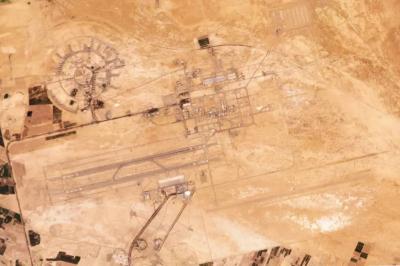When Iran and Israel exchanged drone and missile attacks earlier this month, the world braced for a full-scale war in the Middle East. Ultimately, after both sides made their positions clear with "limited bombings," they allowed matters to settle, according to a report by "The Economist." The report adds: "New satellite images show how Iran saved face and retreated: it simply replaced the destroyed air defense radar with a new one."
On April 19, in response to an Iranian bombing, Israel retaliated with what is believed to be air-launched ballistic missiles targeting an airbase not far from the Natanz nuclear complex south of Tehran. This site has been central to the Iranian nuclear program since it was publicly revealed 22 years ago and is heavily defended by the Russian-made S-300 air defense system.
Satellite images indicated that the Israeli attack on the eighth airbase in Isfahan, located 340 km south of Tehran, hit a significant, specific part of the Russian-made S-300 air defense system. The images showed that the strike resulted in damage or destruction of the "Tomb Stone" 30N6E2 radar, which is used in S-300 systems to track incoming targets.
The images also revealed that other areas of the airbase and the adjacent airport went unscathed, despite the proximity of many sensitive sites. This suggests that Israel intentionally chose a narrow and specific target: the air defense system.
Iran had received Russian-made S-300 air defense systems to deter Israeli airstrikes and other threats. Notably, Tehran had downplayed this attack in earlier statements from its officials, denying that it faced any Israeli missiles or strikes, merely claiming to have shot down a few drones.
According to "The Economist," satellite images show that the Israeli attack targeted the 30N6E2 "Tomb Stone" radar, designed to track airborne and missile threats, allowing intercepting missiles to target them. The magazine cites image analyst Chris Biggers, who previously worked for the U.S. government, stating that the Israeli missiles achieved a direct hit on the Iranian radar.
Biggers confirms that the Iranians moved the remaining components of the targeted battery to a remote location and then, a day later, exchanged it for a different radar model, the 96L6E "Cheese Board," placing it in the same spot. He also noted that the Iranians kept the launch containers for the intercepting missiles upright, as if ready for launch.
Biggers concluded: "It’s a case of denial and deception, indicating that the site is still operational." He emphasized that the location is no longer effective, as the two radar types are not interchangeable, and the battery systems would not function if any of their parts were damaged or replaced with a different type.
The magazine states that "it is unlikely Iran can deceive the U.S. or Israel with this maneuver, as they possess advanced satellites and will easily know that the battery is destroyed."




